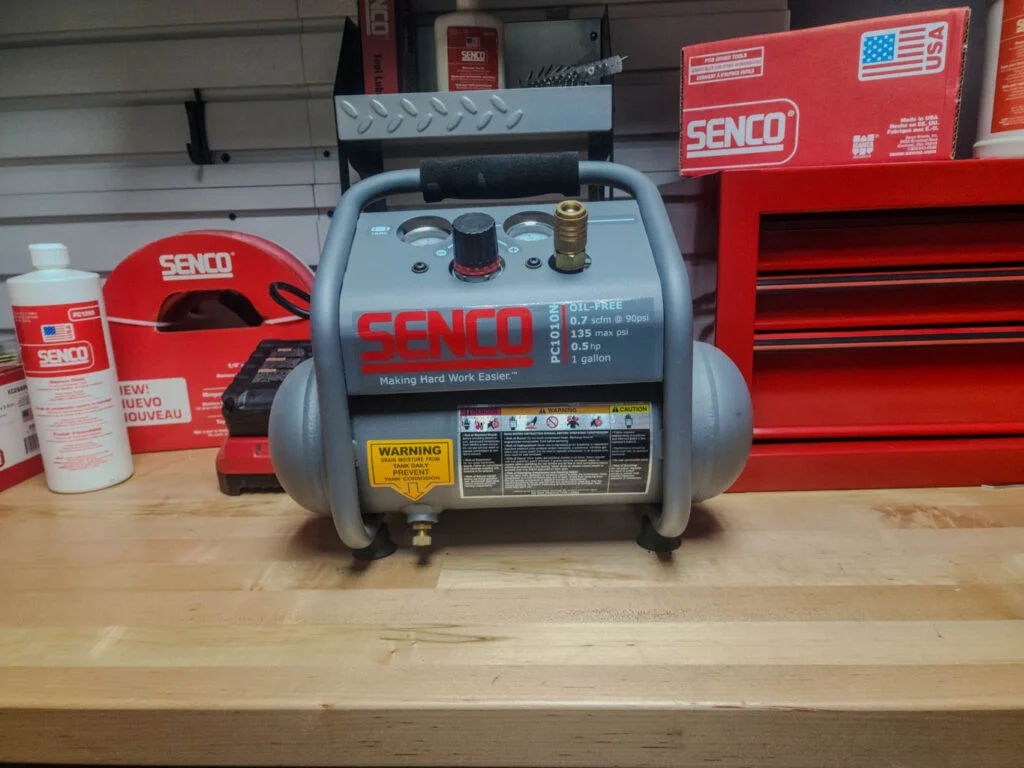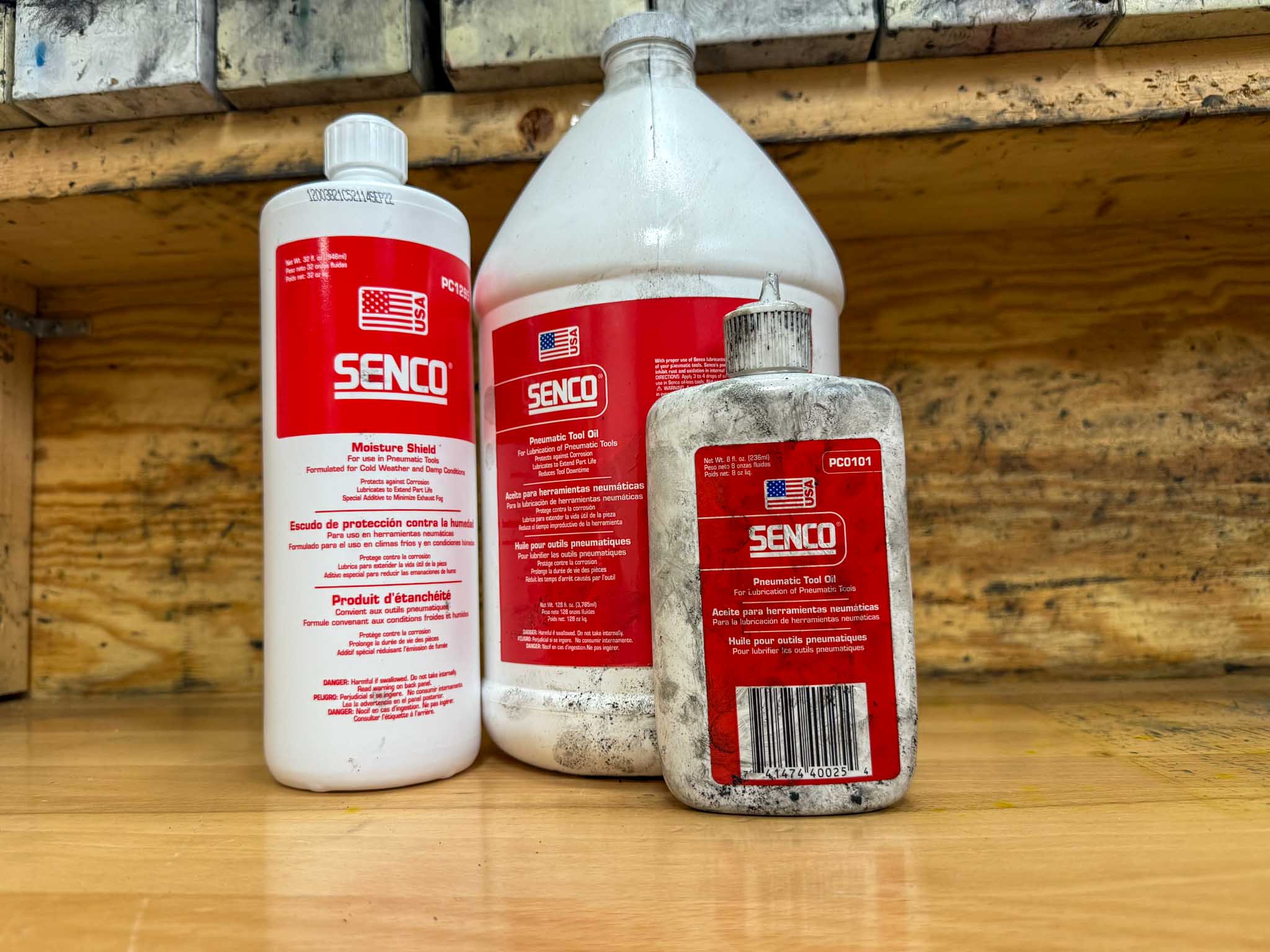What Air Compressor Should I Use for My Tool?

Here’s how to figure out which compressor is best for nailers, sprayers, air hammers, and more.
When you want to get the job done right, finding the best portable air compressor is as critical as selecting the right pneumatic tool.
Compressors are the powerhouses for pneumatic tools, creating the high-pressure bursts of air that drive nailers, staplers, impact wrenches, sanders, and paint sprayers — and doing other odd jobs, like filling your car tires or dusting off machinery.
To figure out what kind of portable compressor you need for your job, you should understand a few common terms and measurements and how they work together.
Air Compressor Overview
In simple terms, an air compressor is a device that takes air at normal pressure and forces it into lower-volume chambers to pressurize it before storing it in a steel tank.
There are several ways compressors intake and pressurize air — typically using pistons or rotary screw devices — but most types of compressors for pneumatic tools use similar terms to measure performance.
SCFM (commonly known as CFM)
Standard Cubic Feet per Minute measures airflow — specifically, the volume of air that can be pushed through an air compressor in 60 seconds. Higher SCFM compressors will fill tanks faster.
This measurement considers standard air pressure to be 70 degrees Fahrenheit with 36 percent humidity at sea level. Different climates and elevations may slightly affect the performance of an air compressor.
SCFM is commonly measured at 90 PSI, an average setting for pneumatic tools. However, setting your compressor to higher PSI can reduce effective SCFM.
When using a tool that requires a higher PSI, such as a framing nailer, or a tool that releases continuous bursts of air, such as a paint sprayer, higher SCFM or HP will lead to fewer interruptions while you wait for tanks to refill.
HP
Horsepower is a common measurement for the amount of power a motor can produce. As it relates to compressors, it is sometimes used interchangeably with SCFM. Higher horsepower motors produce more revolutions per minute of a compressor’s air-intake device. The more revolutions per minute, the higher the SCFM and the faster the tank will refill.
Max PSI
Pounds per Square Inch measures the amount of force compressed air exerts on one square inch of space. Higher PSI delivers more power but reduces SCFM — pump-up time slows down as more air is forced into the tank.
For evaluating compressors, max PSI is generally less important than SCFM or HP. Most compressors for pneumatic tools allow the user to set their desired PSI, generally up to 125 to 150 PSI. 100 PSI is more than enough to power most common construction tools. However, higher PSI may be needed when the tool encounters more resistance, such as when driving long nails into dense lumber or removing a rusted bolt with an impact wrench.
Gallons
This is simply a measurement of the storage capacity of an air compressor’s tank. The smaller the tank, the quicker it will drain. However, higher HP and SCFM compressors will refill more quickly, which can make tank size somewhat less important than it seems at a glance.
Portable air compressors vary in size from 1 to 6 gallons. When selecting a compressor, it’s important to consider factors such as its intended application, portability, required PSI, and the number of tools it will operate. In workshops and industrial settings where mobility is not required, stationary compressors can reach 60 gallons or more.
Amps
Amps measure electrical current. Generally, higher HP motors will draw more amps, but amps should not necessarily be used to evaluate the power, fill speed, or efficiency of the tool.
Instead, use a compressor’s amperage to judge whether you have an adequate power supply available. Plugging a 20-amp tool into a standard 15-amp outlet, for example, could lead to tripped breakers or fire hazards.
Air Requirements By Tool
With a basic overview of terminology, and how performance measurements interact with one another, it’s easier to determine what type of air compressor you need for various tools and jobs. Use this chart as a starting point — but keep in mind that your needs may vary based on your jobs, tool, materials, and available power supply.
| TOOL | HP | SCFM | PSI | GALLON TANK |
| Blow Gun | 1.5 | 2.5 | 30 (OSHA Standard) | 2.5 |
| Inflator | 1.5 | 1 | Variable (Set PSI to tire/ball/etc. requirements) | 2.5 |
| Pin Nailer | 0.5 | 0.7 | 60-100 | 1 |
| Brad Nailer | 0.5 | 0.7 | 70-120 | 1 |
| Stapler | 0.5 | 0.7 | 70-120 | 1 |
| Finish Nailer | 1 | 2.2 | 70-120 | 2.5 |
| Framing Nailer | 2 | 4.5 | 70-120 | 4+ |
| Air Wrench | 2 | 4.5 | 90 | 4+ |
| Air Hammer | 2 | 4.5 | 90 | 4+ |
| Air Sander | 2 | 4.5 | 90 | 4+ |
| Paint Sprayer | 3 | 10 | 30-50 | 4+ |
If you’re still not sure which compressor you need, or if you’re powering multiple tools, aim for a larger compressor with higher HP and SCFM. The PSI can be adjusted to match most needs.
Other Considerations
When selecting a portable air compressor, there are other factors that should weigh into the purchase beyond the performance figures, such as:
Weight
Heavy motor components and steel tanks make compressors a heavier lift than many portable tools. When your compressor needs to be moved frequently, a smaller, lighter compressor can prevent fatigue.
Number of Couplers
When multiple pneumatic tools are used on the same job site, or if you regularly switch between tools, a single compressor with two or more outlets can be an efficient choice. Make sure your compressor has the performance to run multiple tools at once.
Decibels
When working indoors, or on any job site while you’re near your compressor, a quieter motor can improve communication between teammates and make for a more comfortable working environment.
Design Features
A well-balanced compressor with a non-slip grip can feel much lighter than it really is. Other features, such as non-slip rubber feet, roll cages and protective shrouds, and easy-to-understand controls and gauges, improve durability and ease-of-use.
Choosing and maintaining the right air compressor is not merely a matter of convenience; it’s a strategic decision that can improve productivity and project outcomes. Speak to your local dealer about your specific needs to get the right compressor for the job.

